标签:clang div target 环境变量 com lsof armv7s des object
今天是逆向开发的第5天内容--MachO文件(Mac 和 iOS 平台可执行的文件),在逆向开发中是比较重要的,下面我们着重讲解一下MachO文件的基本内容和使用。
Mach-O是Mach Object文件格式的缩写,iOS以及Mac上可执行的文件格式,类似Window的exe格式,Linux上的elf格式。Mach-O是一个可执行文件、动态库以及目标代码的文件格式,是a.out格式的替代,提供了更高更强的扩展性。
Mach-O常见格式如下:
通过file文件路径查看文件类型
我们通过部分实例代码来简单研究一下。
通过test.c 文件,可以使用clang命令将其编译成目标文件.o
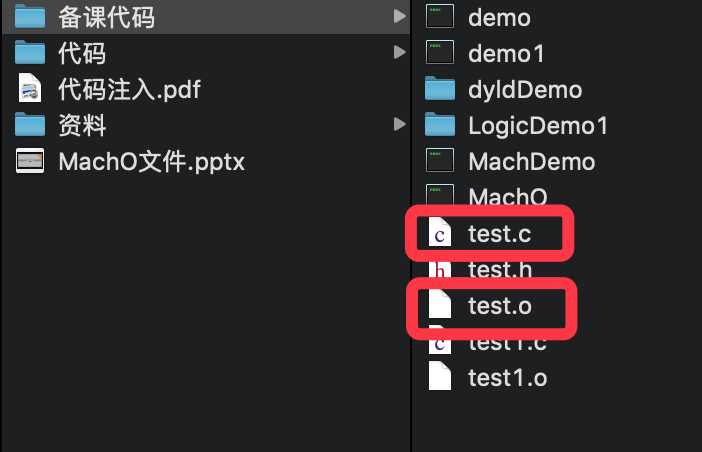
我们再通过file命令(如下)查看文件类型

是个Mach-O文件。
通过cd /usr/lib命令查看dylib

通过file命令查看文件类型

下面是一个截图来说明.dsym是也是Mach-O文件格式

以上只是Mach-O常见格式的某一种,大家可以通过命令来尝试。
希望大家在了解App二进制架构的时候,可以先读一下本人写的另一篇博客关于armv7,armv7s以及arm64等的介绍。https://www.cnblogs.com/guohai-stronger/p/9447364.html
通用二进制文件是苹果自身发明的,基本内容如下
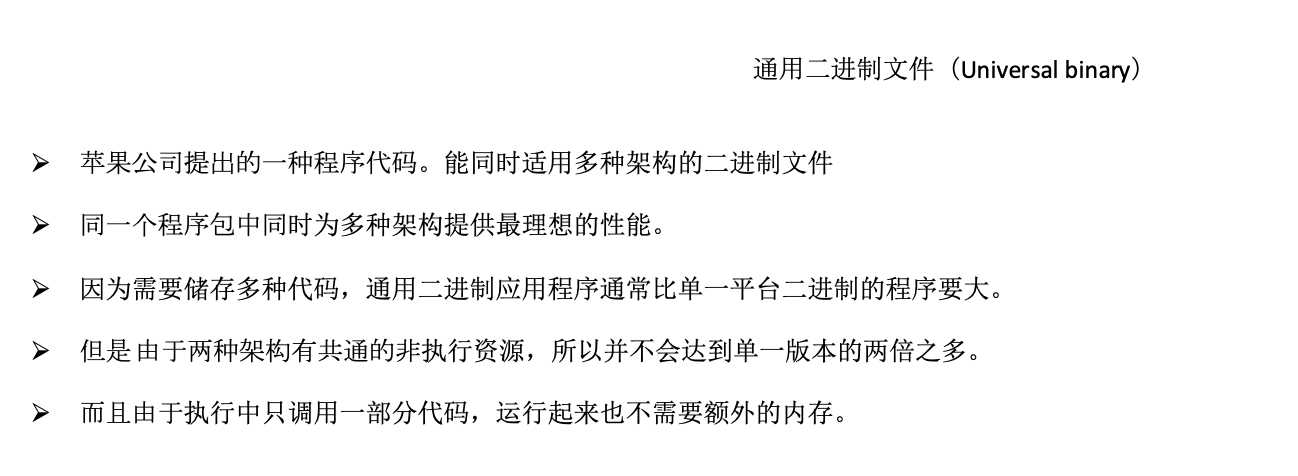
下面通过指令查看Macho文件来看下通用二进制文件
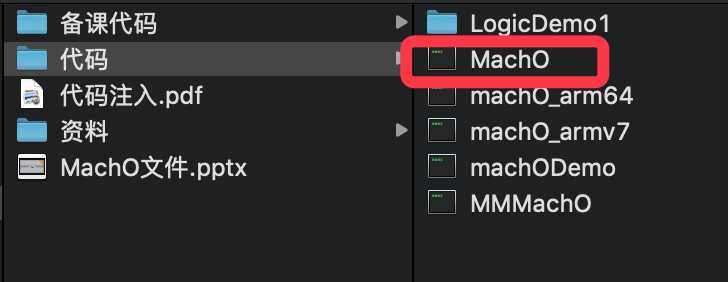
然后通过file指令查看文件类型

上面该MachO文件包含了3个架构分别是arm v7,arm v7s 以及arm 64 。
针对该MachO文件我们做几个操作,利用lipo命令拆分合并架构
![]()
利用lipo-thin瘦身架构
![]()
查看一下结果如下,多出来一个新建的MachO_armv7

利用lipo -create 合并多种架构

发现多出一种框架,合并成功多出Demo可执行文件。结果如下:
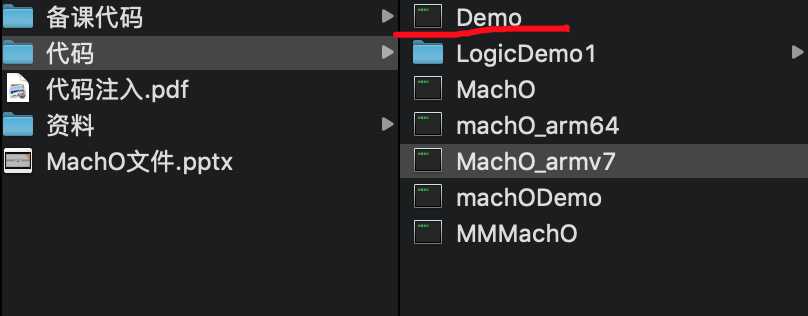
整理出lipo命令如下:
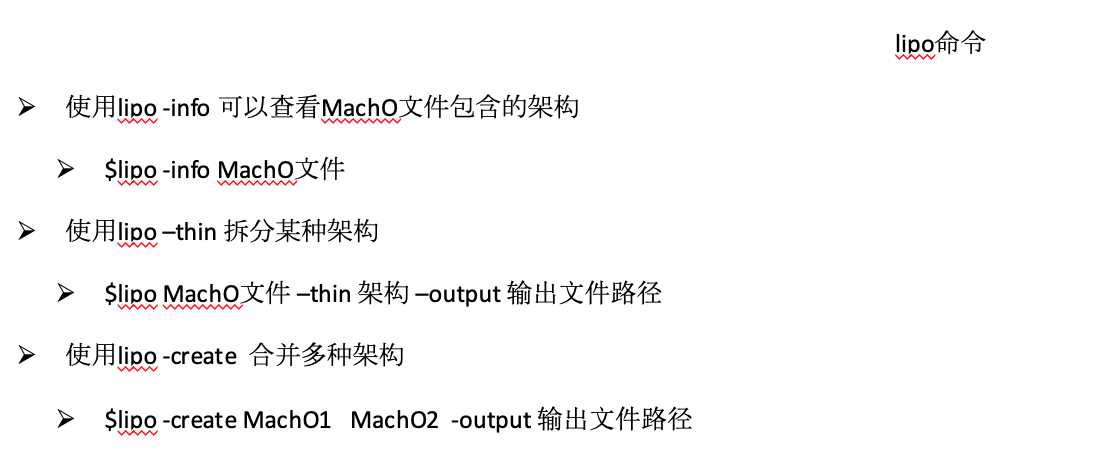
下面是苹果官方图解释MachO文件结构图
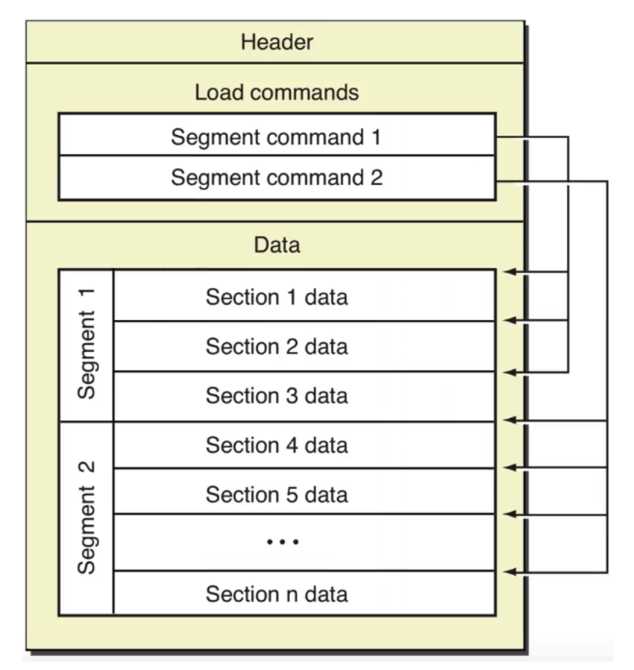
MachO文件的组成结构如上,看包括了三个部分
在项目代码中,按下Command+ 空格,然后输入loader.h
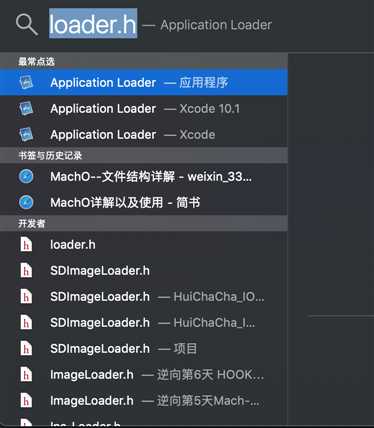
然后查看loader.h文件,找到mach_header

上面是mach_header,对应结构体的意义如下:

通过MachOView查看Mach64 Header头部信息

LoadCommand包含了很多内容的表,通过MachOView查看LoadCommand的信息,图如下:
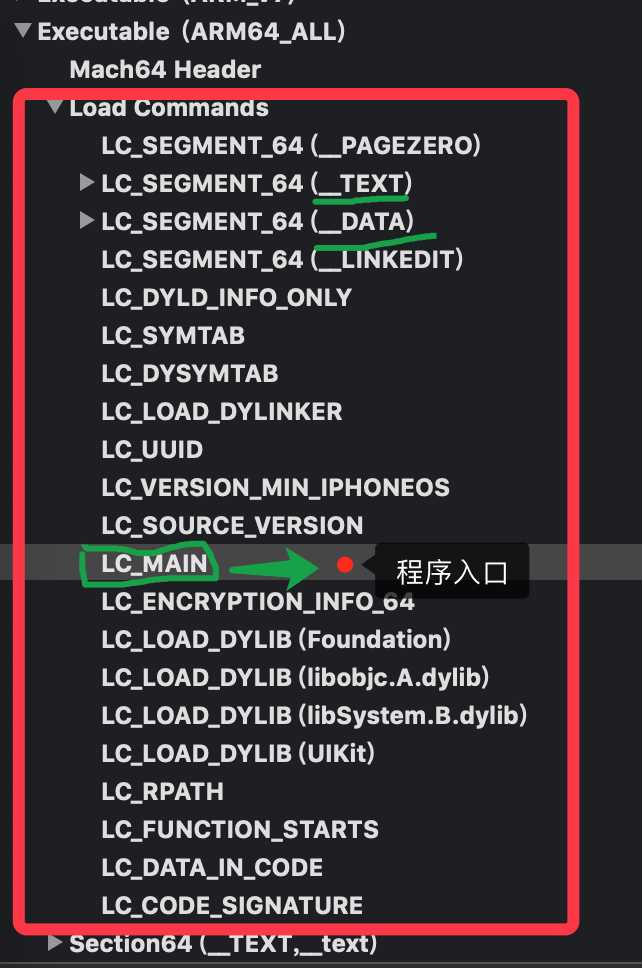
但是大家看的可能并不了解内容,下面有图进行注解,可以看下主要的意思
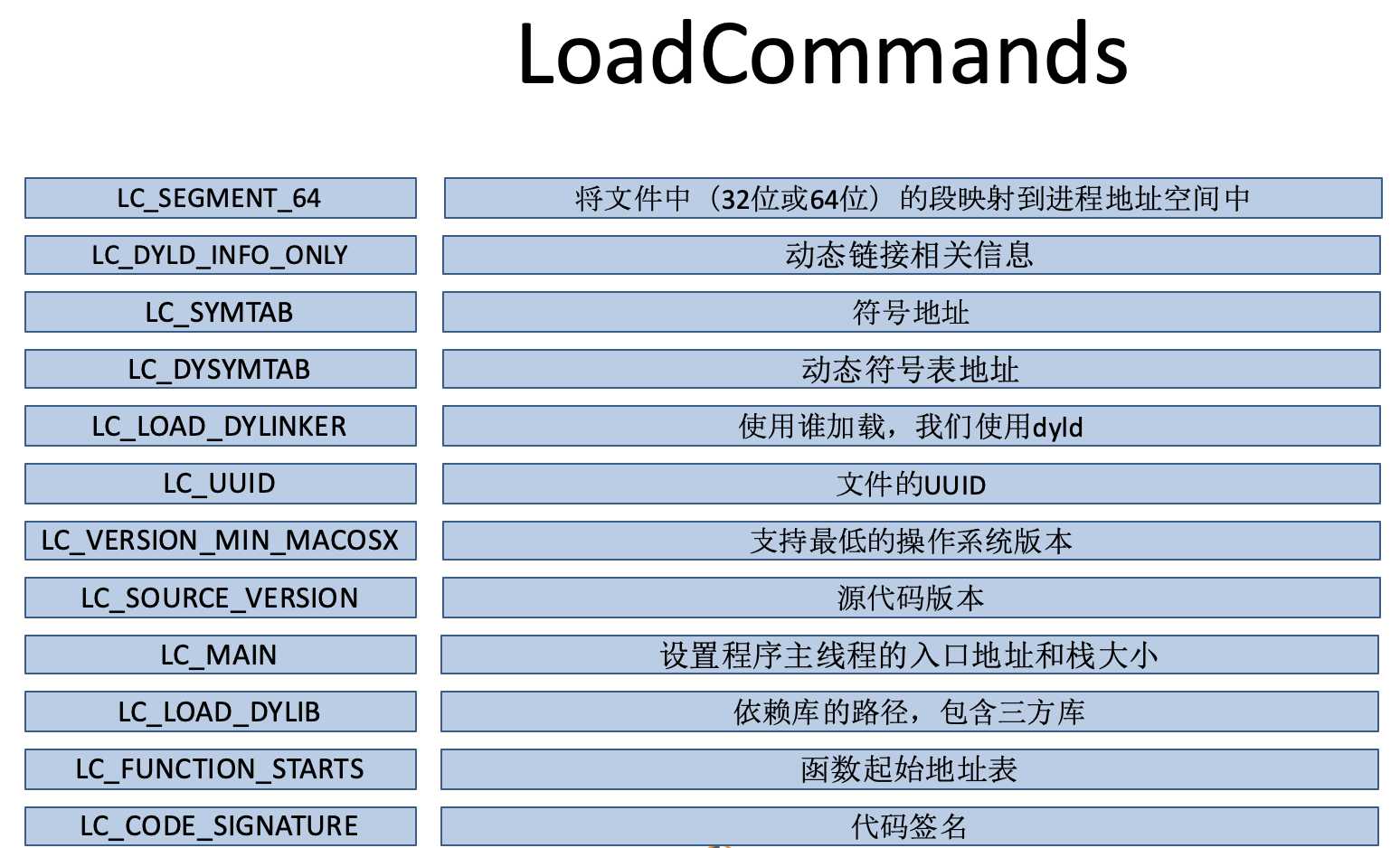
Data包含Segement,存储具体数据,通过MachOView查看,地址映射内容
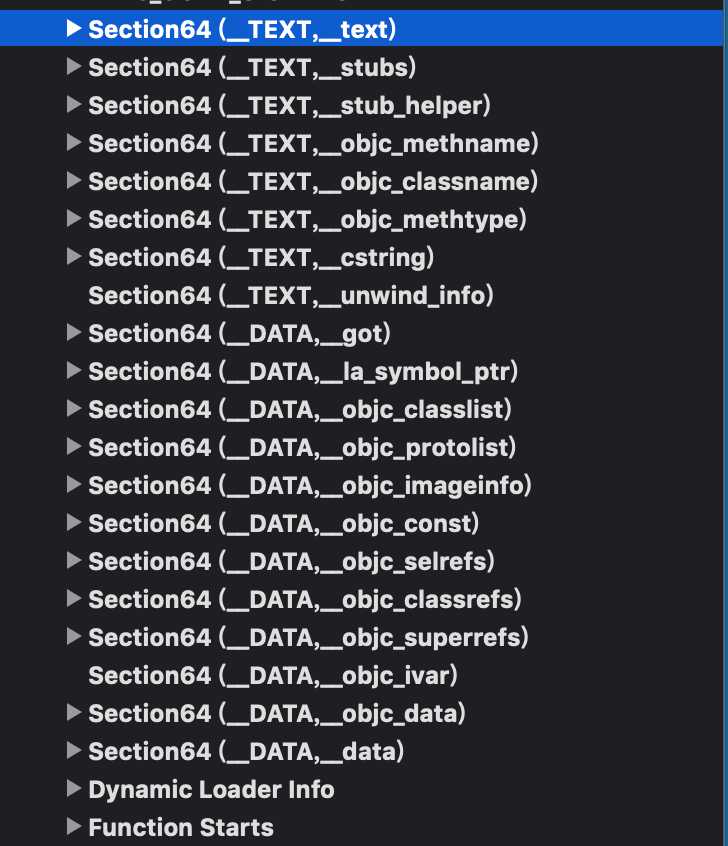
dyld(the dynamic link editor)是苹果动态链接器,是苹果系统一个重要的组成部分,系统内核做好准备工作之后,剩下的就会交给了dyld。
程序的入口一般都是在main函数中,但是比较少的人关心main()函数之前发生了什么?这次我们先探索dyld的加载过程。(但是比在main函数之前,load方法就在main函数之前)

main()之前有个libdyld.dylib start入口,但是不是我们想要的,根据dyld源码找到__dyld_start函数
dyld main()函数是关键函数,下面是函数实现内容。(此时的main实现函数和程序App的main 函数是不一样的,因为dyld也是一个可执行文件,也是具有main函数的)

// // Entry point for dyld. The kernel loads dyld and jumps to __dyld_start which // sets up some registers and call this function. // // Returns address of main() in target program which __dyld_start jumps to // uintptr_t _main(const macho_header* mainExecutableMH, uintptr_t mainExecutableSlide, int argc, const char* argv[], const char* envp[], const char* apple[], uintptr_t* startGlue) { // Grab the cdHash of the main executable from the environment // 第一步,设置运行环境 uint8_t mainExecutableCDHashBuffer[20]; const uint8_t* mainExecutableCDHash = nullptr; if ( hexToBytes(_simple_getenv(apple, "executable_cdhash"), 40, mainExecutableCDHashBuffer) ) // 获取主程序的hash mainExecutableCDHash = mainExecutableCDHashBuffer; // Trace dyld‘s load notifyKernelAboutImage((macho_header*)&__dso_handle, _simple_getenv(apple, "dyld_file")); #if !TARGET_IPHONE_SIMULATOR // Trace the main executable‘s load notifyKernelAboutImage(mainExecutableMH, _simple_getenv(apple, "executable_file")); #endif uintptr_t result = 0; // 获取主程序的macho_header结构 sMainExecutableMachHeader = mainExecutableMH; // 获取主程序的slide值 sMainExecutableSlide = mainExecutableSlide; CRSetCrashLogMessage("dyld: launch started"); // 设置上下文信息 setContext(mainExecutableMH, argc, argv, envp, apple); // Pickup the pointer to the exec path. // 获取主程序路径 sExecPath = _simple_getenv(apple, "executable_path"); // <rdar://problem/13868260> Remove interim apple[0] transition code from dyld if (!sExecPath) sExecPath = apple[0]; if ( sExecPath[0] != ‘/‘ ) { // have relative path, use cwd to make absolute char cwdbuff[MAXPATHLEN]; if ( getcwd(cwdbuff, MAXPATHLEN) != NULL ) { // maybe use static buffer to avoid calling malloc so early... char* s = new char[strlen(cwdbuff) + strlen(sExecPath) + 2]; strcpy(s, cwdbuff); strcat(s, "/"); strcat(s, sExecPath); sExecPath = s; } } // Remember short name of process for later logging // 获取进程名称 sExecShortName = ::strrchr(sExecPath, ‘/‘); if ( sExecShortName != NULL ) ++sExecShortName; else sExecShortName = sExecPath; // 配置进程受限模式 configureProcessRestrictions(mainExecutableMH); // 检测环境变量 checkEnvironmentVariables(envp); defaultUninitializedFallbackPaths(envp); // 如果设置了DYLD_PRINT_OPTS则调用printOptions()打印参数 if ( sEnv.DYLD_PRINT_OPTS ) printOptions(argv); // 如果设置了DYLD_PRINT_ENV则调用printEnvironmentVariables()打印环境变量 if ( sEnv.DYLD_PRINT_ENV ) printEnvironmentVariables(envp); // 获取当前程序架构 getHostInfo(mainExecutableMH, mainExecutableSlide); //-------------第一步结束------------- // load shared cache // 第二步,加载共享缓存 // 检查共享缓存是否开启,iOS必须开启 checkSharedRegionDisable((mach_header*)mainExecutableMH); if ( gLinkContext.sharedRegionMode != ImageLoader::kDontUseSharedRegion ) { mapSharedCache(); } ... try { // add dyld itself to UUID list addDyldImageToUUIDList(); // instantiate ImageLoader for main executable // 第三步 实例化主程序 sMainExecutable = instantiateFromLoadedImage(mainExecutableMH, mainExecutableSlide, sExecPath); gLinkContext.mainExecutable = sMainExecutable; gLinkContext.mainExecutableCodeSigned = hasCodeSignatureLoadCommand(mainExecutableMH); // Now that shared cache is loaded, setup an versioned dylib overrides #if SUPPORT_VERSIONED_PATHS checkVersionedPaths(); #endif // dyld_all_image_infos image list does not contain dyld // add it as dyldPath field in dyld_all_image_infos // for simulator, dyld_sim is in image list, need host dyld added #if TARGET_IPHONE_SIMULATOR // get path of host dyld from table of syscall vectors in host dyld void* addressInDyld = gSyscallHelpers; #else // get path of dyld itself void* addressInDyld = (void*)&__dso_handle; #endif char dyldPathBuffer[MAXPATHLEN+1]; int len = proc_regionfilename(getpid(), (uint64_t)(long)addressInDyld, dyldPathBuffer, MAXPATHLEN); if ( len > 0 ) { dyldPathBuffer[len] = ‘\0‘; // proc_regionfilename() does not zero terminate returned string if ( strcmp(dyldPathBuffer, gProcessInfo->dyldPath) != 0 ) gProcessInfo->dyldPath = strdup(dyldPathBuffer); } // load any inserted libraries // 第四步 加载插入的动态库 if ( sEnv.DYLD_INSERT_LIBRARIES != NULL ) { for (const char* const* lib = sEnv.DYLD_INSERT_LIBRARIES; *lib != NULL; ++lib) loadInsertedDylib(*lib); } // record count of inserted libraries so that a flat search will look at // inserted libraries, then main, then others. // 记录插入的动态库数量 sInsertedDylibCount = sAllImages.size()-1; // link main executable // 第五步 链接主程序 gLinkContext.linkingMainExecutable = true; #if SUPPORT_ACCELERATE_TABLES if ( mainExcutableAlreadyRebased ) { // previous link() on main executable has already adjusted its internal pointers for ASLR // work around that by rebasing by inverse amount sMainExecutable->rebase(gLinkContext, -mainExecutableSlide); } #endif link(sMainExecutable, sEnv.DYLD_BIND_AT_LAUNCH, true, ImageLoader::RPathChain(NULL, NULL), -1); sMainExecutable->setNeverUnloadRecursive(); if ( sMainExecutable->forceFlat() ) { gLinkContext.bindFlat = true; gLinkContext.prebindUsage = ImageLoader::kUseNoPrebinding; } // link any inserted libraries // do this after linking main executable so that any dylibs pulled in by inserted // dylibs (e.g. libSystem) will not be in front of dylibs the program uses // 第六步 链接插入的动态库 if ( sInsertedDylibCount > 0 ) { for(unsigned int i=0; i < sInsertedDylibCount; ++i) { ImageLoader* image = sAllImages[i+1]; link(image, sEnv.DYLD_BIND_AT_LAUNCH, true, ImageLoader::RPathChain(NULL, NULL), -1); image->setNeverUnloadRecursive(); } // only INSERTED libraries can interpose // register interposing info after all inserted libraries are bound so chaining works for(unsigned int i=0; i < sInsertedDylibCount; ++i) { ImageLoader* image = sAllImages[i+1]; image->registerInterposing(); } } // <rdar://problem/19315404> dyld should support interposition even without DYLD_INSERT_LIBRARIES for (long i=sInsertedDylibCount+1; i < sAllImages.size(); ++i) { ImageLoader* image = sAllImages[i]; if ( image->inSharedCache() ) continue; image->registerInterposing(); } ... // apply interposing to initial set of images for(int i=0; i < sImageRoots.size(); ++i) { sImageRoots[i]->applyInterposing(gLinkContext); } gLinkContext.linkingMainExecutable = false; // <rdar://problem/12186933> do weak binding only after all inserted images linked // 第七步 执行弱符号绑定 sMainExecutable->weakBind(gLinkContext); // If cache has branch island dylibs, tell debugger about them if ( (sSharedCacheLoadInfo.loadAddress != NULL) && (sSharedCacheLoadInfo.loadAddress->header.mappingOffset >= 0x78) && (sSharedCacheLoadInfo.loadAddress->header.branchPoolsOffset != 0) ) { uint32_t count = sSharedCacheLoadInfo.loadAddress->header.branchPoolsCount; dyld_image_info info[count]; const uint64_t* poolAddress = (uint64_t*)((char*)sSharedCacheLoadInfo.loadAddress + sSharedCacheLoadInfo.loadAddress->header.branchPoolsOffset); // <rdar://problem/20799203> empty branch pools can be in development cache if ( ((mach_header*)poolAddress)->magic == sMainExecutableMachHeader->magic ) { for (int poolIndex=0; poolIndex < count; ++poolIndex) { uint64_t poolAddr = poolAddress[poolIndex] + sSharedCacheLoadInfo.slide; info[poolIndex].imageLoadAddress = (mach_header*)(long)poolAddr; info[poolIndex].imageFilePath = "dyld_shared_cache_branch_islands"; info[poolIndex].imageFileModDate = 0; } // add to all_images list addImagesToAllImages(count, info); // tell gdb about new branch island images gProcessInfo->notification(dyld_image_adding, count, info); } } CRSetCrashLogMessage("dyld: launch, running initializers"); ... // run all initializers // 第八步 执行初始化方法 initializeMainExecutable(); // notify any montoring proccesses that this process is about to enter main() dyld3::kdebug_trace_dyld_signpost(DBG_DYLD_SIGNPOST_START_MAIN_DYLD2, 0, 0); notifyMonitoringDyldMain(); // find entry point for main executable // 第九步 查找入口点并返回 result = (uintptr_t)sMainExecutable->getThreadPC(); if ( result != 0 ) { // main executable uses LC_MAIN, needs to return to glue in libdyld.dylib if ( (gLibSystemHelpers != NULL) && (gLibSystemHelpers->version >= 9) ) *startGlue = (uintptr_t)gLibSystemHelpers->startGlueToCallExit; else halt("libdyld.dylib support not present for LC_MAIN"); } else { // main executable uses LC_UNIXTHREAD, dyld needs to let "start" in program set up for main() result = (uintptr_t)sMainExecutable->getMain(); *startGlue = 0; } } catch(const char* message) { syncAllImages(); halt(message); } catch(...) { dyld::log("dyld: launch failed\n"); } ... return result; }
折叠开dyld main函数,步骤总结如下
对待dyld的讲述,是非常不易的,因为本身过程是比较复杂的,上面仅仅是自身的抽出来的。下面再画一张流程图,帮助大家理解。
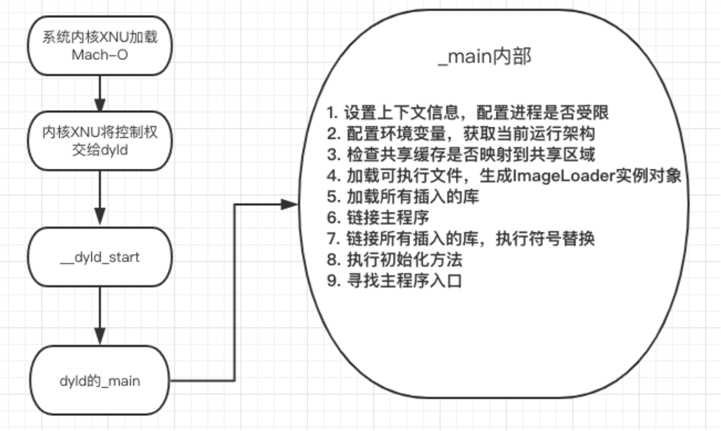
MachO文件对于逆向开发是非常重要的,通过本次讲解,希望对大家理解逆向开发有所帮助,也希望大家真正可以提高技术,应对iOS市场的大环境,下一篇我们将讲述Hook原理--逆向开发。谢谢!!!
标签:clang div target 环境变量 com lsof armv7s des object
原文地址:https://www.cnblogs.com/guohai-stronger/p/11915571.html